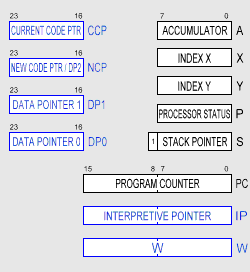LAUGHTON ELECTRONICS |
|
The KimKlone: Bride of Son of Cheap Video |
|
Conclusion (Konklusion) |
|
|
The KimKlone served as my lab computer for years, and it would qualify as a success even without the exotic IP and W features. I didn't absolutely need that extra speed. (But I did rely on the extra address space and of course the "Cheap Video" style video interface!) The KK proved very satisfying as a design exercise. It was fun scheming out the microcode hardware and firmware, and naturally I'm fascinated by the endless possibilities of Instruction Set design. Obviously I'm not the first to undertake the expansion of an existing Instruction Set. But I was surprised to discover how much could be accomplished, despite the constraints of working with existing silicon. In fact the KK is superior (from the programmer's perspective) to at least one commercially produced monolithic device, the MOS 6509 microprocessor. (Both are 65xx designs intended to expand the 64K address range.) Certainly the KimKlone project put my imagination to the test, and it was a pretty intriguing exercise at times. Besides the big picture, there were some novel low-level problems to solve, such as how to keep the microcode in sync despite the CPU timing variability from indirect-Y page crossings, and how to make a VIA chip count up even though the data sheet only mentions counting down. (Care to guess at the solutions? Give up? See the KK FAQ.) I'll conclude the article here, with additions to follow if I get time. If you're curious about anything (or find anything to be unclear), by all means let me know. Certainly there's quite a lot I haven't explained yet: about dealing with interrupts, about the 1.44MB floppy disk system (a separate, custom single-board computer), the video interface to the KK's bit-mapped LCD display panel, the... |
|
| <Previous Page | KK Index |
| remember to visit LAUGHTON ELECTRONICS |
Home Commercial& Manufacturing Stage&Studio Laboratory&OEM |
 |
|

